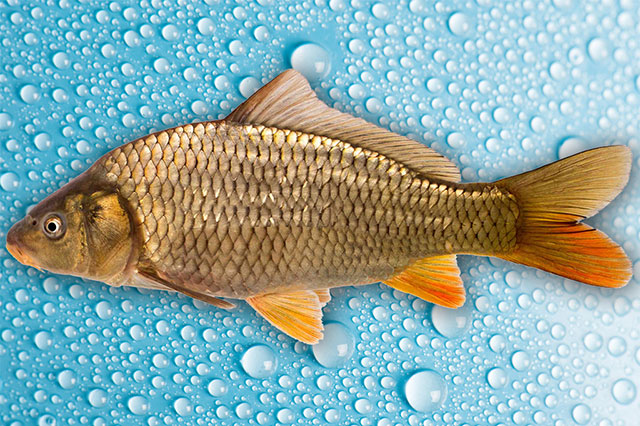
CARP
Genus: Cyprinus carpio
Specification:
| Land | Packaging | *Mass | Type |
|---|---|---|---|
| Serbia | Bulk | 5 kg | Cutlet |
* Mass of goods in a transport box packaging
Carp is the most significant fish of lowland rivers, both from a sporting and an economic perspective. Of all fish, it is the most common on our tables, especially farmed carp – mirror carp – (lat. Cyprinus carpio morpha hungaricus). Farmed carp has been selectively bred to achieve greater growth with abundant food. The profile of the wild carp (lat. Cyprinus carpio morpha regina) ranges between 3.5 kg and 4.5 kg, its body covered with large scales, brown on top, golden-yellow on the sides, and light-yellow on the belly. The profile of farmed carp is 2 to 2.5 kg.
Carp is the most well-known and popular fish for angling in our regions. As it has been the most popular fish for centuries, carp have become increasingly smarter and craftier over generations. Today, carp are by far the most intelligent and tame freshwater fish species. Experienced carp, which can be over 50 years old and have faced hooks, various baits, and rigs for years, can become extremely cunning and cautious, easily avoiding anglers' hooks. It often happens that carp play with the bait, as if to let the angler know that they recognize it as bait and will not be tricked.
Through selective breeding for specific traits, such as the number of scales, bone content, and muscle mass, tame or farmed carp varieties have been bred from river carp over many years. The main characteristics of these cultivated strains are a high back and a strong, wide body full of muscle. In addition, they grow faster and make better use of food. In natural conditions of free spawning, crossbreeding gradually leads them to lose their bred traits, reverting to their original form.
Lifestyle and Diet
In fishponds and lakes, favorable spawning conditions are often lacking, so such waters are regularly restocked. Shallow areas with lush vegetation are necessary for spawning. These are usually flooded meadows or shallow waters overgrown with reeds and sedges. The shallower the water, the quicker it warms, and higher water temperature is required for egg incubation. Dense vegetation and shallow water protect the eggs from other fish that might eat them. Larger females usually lead the search for spawning grounds, followed by several males. Often, carp enter extremely shallow water, only a few dozen centimeters deep. Their backs stick out of the water and they nearly beach themselves on the shore. Unfortunately, such behavior and spawning sites are long known to poachers, so in many natural, wild spawning areas, a large number of big carp are killed every year. If carp do not find suitable spawning grounds, the female will not release her eggs. Females that fail to release eggs can, in rare cases, even die. In commercial fishponds, eggs are manually pressed from large females (broodstock) and fertilized with the milt of males. The fertilized eggs are kept in tanks (incubators), and once hatched, the fry are released into separate ponds.
Nutritional Values
The meat has unique organoleptic properties and belongs to the group of highest-quality foods. It is light pink, easily digestible, quickly absorbed, high in nutrients, yet low in calories (100 kcal/100 g) or 420 kJ. Protein content is 17%, fat 3%, minerals 1.2%. It is a rich source of vitamins A, D, and B group, as well as magnesium, phosphorus, iodine, and fluorine. In addition to its low cholesterol content (50 mg/100 g), it contains significant amounts of polyunsaturated fatty acids (omega-3 and omega-6). Due to their beneficial effects on human health, especially in preventing coronary diseases, it is recommended to consume carp 2–3 times a week.
back